新概念第一册主要语法知识
新概念英语第一册语法汇总
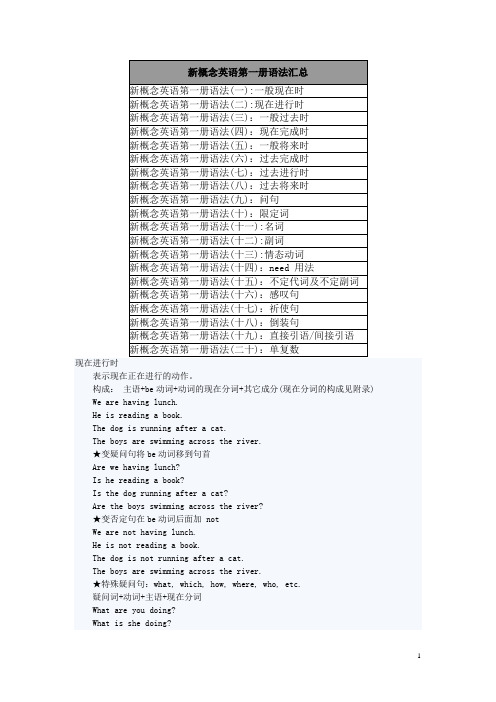
What is the dog doing?没有进行时的动词(必背)表示状态,思想,感情和感觉的动词不能表示正在进行的动作1. 表示感觉,感官的词see, hear, like, love, want,2. have, has当”拥有”讲时没有进行时一、时态:一般现在时,现在进行时,一般过去时,现在完成时,一般将来时,过去进行时,过去完成时,过去将来时1. 一般现在时表示一般性,经常性的动作或一般性事实。
1 含有be动词的句子He is a teacher.The girl is very beautiful.Tim and Jack are students.★变疑问句将be动词移到句首Is he a teacher?Is the girl very beautiful?Are Tim and Jack students?★变否定句在be动词后面加notHe is not a teacher.The girl is not very beautiful.Tim and Jack are not students.★肯定回答及否定回答Yes, he is. No, he is not.Yes, she is. No, she is not.Yes, they are. No, they are not.★不含有be动词的句子,即含有一般动词的句子第三人称单数及单数名词He likes books.She likes him.The dog likes bones.★变疑问句在句首加does, 动词变为原型Does he like books?Does she like him?Does the dog like bones?★变否定句在主语及动词之间加doesn’t, 动词变为原型,原句中的动词不再有第三人称变化。
He doesn’t like books.She doesn’t like him.The dog doesn’t like bones.★肯定回答及否定回答:Yes, he does. No, he doesn’t.Yes, she does. No, she doesn’tYes, it does. No, it doesn’t.注意:第三人称单数形式一般在动词后面加S,不要和名词复数混淆,变否定句或疑问句时名词复数没有任何变化。
新概念英语第一册各课语法知识汇总
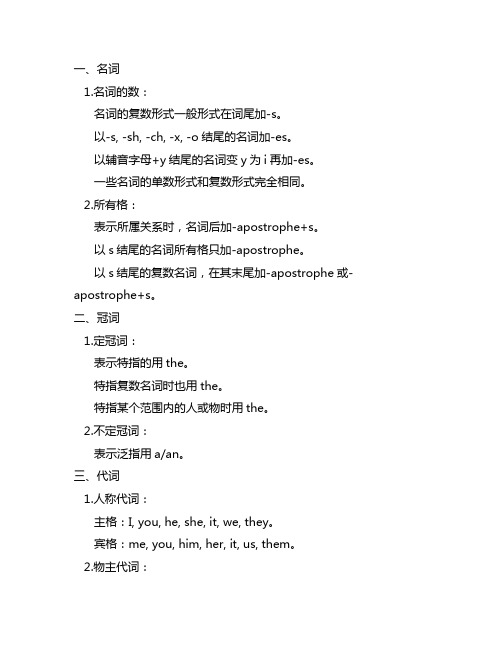
一、名词1.名词的数:名词的复数形式一般形式在词尾加-s。
以-s, -sh, -ch, -x, -o结尾的名词加-es。
以辅音字母+y结尾的名词变y为i再加-es。
一些名词的单数形式和复数形式完全相同。
2.所有格:表示所属关系时,名词后加-apostrophe+s。
以s结尾的名词所有格只加-apostrophe。
以s结尾的复数名词,在其末尾加-apostrophe或-apostrophe+s。
二、冠词1.定冠词:表示特指的用the。
特指复数名词时也用the。
特指某个范围内的人或物时用the。
2.不定冠词:表示泛指用a/an。
三、代词1.人称代词:主格:I, you, he, she, it, we, they。
宾格:me, you, him, her, it, us, them。
2.物主代词:形容词性物主代词:my, your, his, her, its, our, their。
名词性物主代词:mine, yours, his, hers, its, ours, theirs。
3.指示代词:this, that, these, those。
4.不定代词:some, any, no, every, each, many, much, few, little。
四、形容词1.形容词的用法:在名词前作定语。
在系动词之后作表语。
2.比较级和最高级:比较级:比较两者时,用比较级。
最高级:表示三者或三者以上之间的比较。
五、动词1.动词的三单形式:一般情况,动词第三人称单数在末尾加-s。
以辅音字母加y结尾的动词变y为i再加-es。
直接在词尾加-es的动词。
2.动词的现在进行时:am/is/are+动词的现在分词。
3.行为动词的过去式:动词过去式变化规则有规则动词和不规则动词。
六、副词1.副词的用法:修饰动词、形容词、副词。
表示时间、地点、原因、目的等。
2.比较级和最高级:副词比较级和最高级的构成。
七、介词1.介词的基本用法:表示方位、时间、原因、目的等。
新概念一语法知识点总结
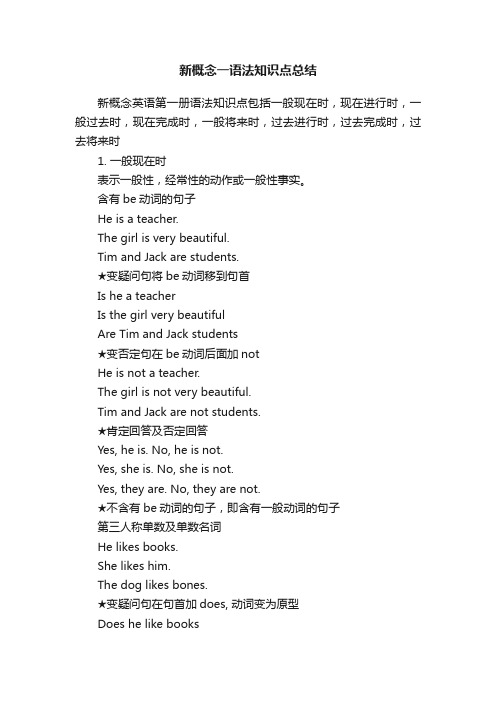
新概念一语法知识点总结新概念英语第一册语法知识点包括一般现在时,现在进行时,一般过去时,现在完成时,一般将来时,过去进行时,过去完成时,过去将来时1. 一般现在时表示一般性,经常性的动作或一般性事实。
含有be动词的句子He is a teacher.The girl is very beautiful.Tim and Jack are students.★变疑问句将be动词移到句首Is he a teacherIs the girl very beautifulAre Tim and Jack students★变否定句在be动词后面加notHe is not a teacher.The girl is not very beautiful.Tim and Jack are not students.★肯定回答及否定回答Yes, he is. No, he is not.Yes, she is. No, she is not.Yes, they are. No, they are not.★不含有be动词的句子,即含有一般动词的句子第三人称单数及单数名词He likes books.She likes him.The dog likes bones.★变疑问句在句首加does, 动词变为原型Does he like booksDoes she like himDoes the dog like bones?★变否定句在主语及动词之间加doesn’t, 动词变为原型,原句中的动词不再有第三人称变化。
He do esn’t like books.She doesn’t like him.The dog doesn’t like bones.★肯定回答及否定回答:Yes, he does. No, he doesn’t.Yes, she does. No, she doesn’tYes, it does. No, it doesn’t.注意:第三人称单数形式一般在动词后面加S,不要和名词复数混淆,变否定句或疑问句时名词复数没有任何变化。
新概念英语第一册重点词汇和语法(完整版)
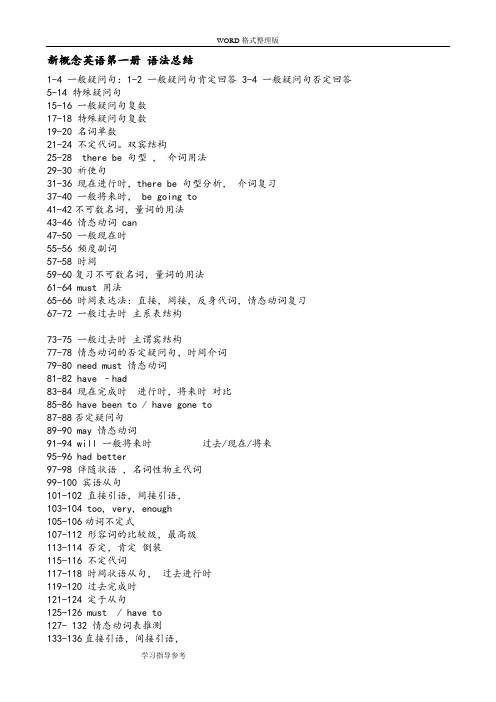
新概念英语第一册语法总结1-4 一般疑问句:1-2 一般疑问句肯定回答 3-4 一般疑问句否定回答5-14 特殊疑问句15-16 一般疑问句复数17-18 特殊疑问句复数19-20 名词单数21-24 不定代词。
双宾结构25-28 there be 句型,介词用法29-30 祈使句31-36 现在进行时,there be 句型分析,介词复习37-40 一般将来时, be going to41-42不可数名词,量词的用法43-46 情态动词 can47-50 一般现在时55-56 频度副词57-58 时间59-60复习不可数名词,量词的用法61-64 must 用法65-66 时间表达法:直接,间接,反身代词,情态动词复习67-72 一般过去时主系表结构73-75 一般过去时主谓宾结构77-78 情态动词的否定疑问句,时间介词79-80 need must 情态动词81-82 have –had83-84 现在完成时进行时,将来时对比85-86 have been to / have gone to87-88否定疑问句89-90 may 情态动词91-94 will 一般将来时过去/现在/将来95-96 had better97-98 伴随状语,名词性物主代词99-100 宾语从句101-102 直接引语,间接引语,103-104 too, very, enough105-106动词不定式107-112 形容词的比较级,最高级113-114 否定,肯定倒装115-116 不定代词117-118 时间状语从句,过去进行时119-120 过去完成时121-124 定于从句125-126 must / have to127- 132 情态动词表推测133-136直接引语,间接引语,137-138 条件状语从句139-140宾语从句141-144 被动语态Lesson 1 Excuse me1. Words1) excuse (1)重音(2)与sorry 的区别(3)Excuse 用的不同场景a. 请别人让路b. 引起别人的注意c. 打断别人的谈话d. 可以当n. 借口 eg. No excuse. 别找借口,没有借口。
新概念英语第一册语法

新概念英语第一册语法New Concept English Book1 语法:1、动词(1)基本结构《新概念英语》第一册中使用到的动词主要是第三人称单数形式,也就是祈使句中通常将动词放在句首。
例如,“Do the work.” (做这项工作)。
此外,还会使用不定式、动词过去式和过去分词。
(2)时态《新概念英语》第一册中使用的时态主要有一般现在时、一般过去时、过去进行时、将来时、过去将来时、虚拟时等。
2、名词(1)基本结构《新概念英语》第一册中名词的最基本结构是单数形式。
单数形式的名词一般会用定冠词“the”、不定冠词“a/an”、不定代词“some”等来定语。
(2)复数形式复数形式的名词,一般伴随着数量词“many”、“few”、“several”等来构成句子。
例如,“Many peopleare here.” (许多人在这里)3、代词(1)基本结构《新概念英语》第一册中使用的主要代词有主格代词、宾格代词、形容词性物主代词和名词性物主代词等。
(2)特殊用法《新概念英语》第一册中使用到的代词在特定情况下会有特殊用法,例如不借助名词就可以表达某事或某人。
例如,“It'smy pen.” (这是我的钢笔),其中“it”是指示代词表示指物,而“my”是形容词性物主代词表示主语。
4、形容词(1)基本结构《新概念英语》第一册中使用的形容词主要用于修饰名词,会用来表达某样东西的特征、性质或状态。
例如,“A big stone.” (一块大石头),其中的“big”表明石头的大小。
(2)特殊用法形容词在英语句子中也可以用来作状语,以阐明动作的方式或速度等。
例如,“He quickly left.” (他迅速离开),其中“quickly”是作状语。
(3)比较级形容词也可以用比较级表示某物比另一物更加强烈的特征或状态。
例如,“This book is bigger than that one.” (这本书比那本书大),其中“bigger”是比较级,表示比较出更强烈的特征。
新概念英语第1册语法知识点

【导语】新概念英语⽂章短⼩精悍,语句幽默诙谐,语法全⾯系统。
适合各个阶层的⼈群学习参考。
相信有了新概念英语,你也可以成为“⼤神”级别的⼈物!还在等什么?快来加⼊学习吧!⽆忧考⼩编与您⼀起学习进步!新概念英语第1册语法知识点:词法 ⼀、动词:(表⽰动作或状态等。
) 1、记住以下常见系动词 Appear Be Become Fall Feel Get Go Grow Keep Look Prove Remain Rest Run Seem Smell Sound Stay Taste Rurn 2、记住以下常见助动词 Be Have Do Will Sould Shall Should 3、记住以下常见情态动词 Can Could May Might Must Ought 4、记住以下常见半情态动词 Need Dare Be able to Have(got)to Had better(best) Used to ⼆、冠词(⽤在名词前帮助说明其词义) 三、名词(表⽰⼈或事物的名称) 四、代词(⽤来代替名词或数词等,包含反⾝代词) 五、形容词(⽤来修饰名词或代词) 六、副词(⽤来修饰动词、形容词、或副词) 七、介词(⽤在名词、代词等前⾯,表⽰与别的词的关系) ⼋、数词(表⽰数⽬或顺序) 九、连词(⽤来加接词与词或句与句) ⼗、感叹词(表⽰说话时的感情或⼝⽓)新概念英语第1册语法知识点:词法规则 ⼀、可数名词的复数规则变化 1、⼀般情况下未尾加“s”。
2、以x,ss,sh,ch,x结尾的名词加“es”。
3、以ce,se,ze,(d)ge结尾的词加“s”。
4、以辅⾳字母+y结尾的词,变“y”为“i”在加“es”。
5、以元⾳字母+y结尾的词,直接加“s”。
6、以f,fe结尾的名词⼀般变“f”或“fe”为“v”在加“es”。
(以f或fe结尾的部分名词可直接加“s”) 7、以o结尾的名词⼀般加“s”。
新概念英语第一册所有语法点汇总)
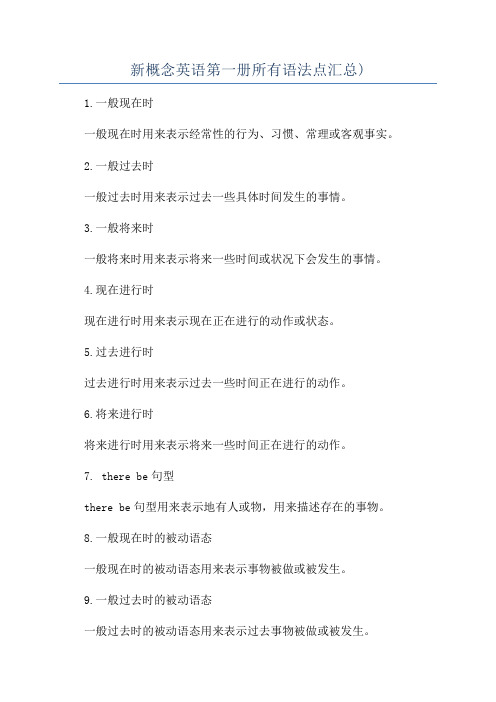
新概念英语第一册所有语法点汇总)1.一般现在时一般现在时用来表示经常性的行为、习惯、常理或客观事实。
2.一般过去时一般过去时用来表示过去一些具体时间发生的事情。
3.一般将来时一般将来时用来表示将来一些时间或状况下会发生的事情。
4.现在进行时现在进行时用来表示现在正在进行的动作或状态。
5.过去进行时过去进行时用来表示过去一些时间正在进行的动作。
6.将来进行时将来进行时用来表示将来一些时间正在进行的动作。
7. there be句型there be句型用来表示地有人或物,用来描述存在的事物。
8.一般现在时的被动语态一般现在时的被动语态用来表示事物被做或被发生。
9.一般过去时的被动语态一般过去时的被动语态用来表示过去事物被做或被发生。
10.一般将来时的被动语态一般将来时的被动语态用来表示将来事物将被做或被发生。
11.现在进行时的被动语态现在进行时的被动语态用来表示事物正在被做或被发生。
12.过去进行时的被动语态过去进行时的被动语态用来表示过去事物正在被做或被发生。
13. do与does的用法do和does用来构成否定句、疑问句和回答。
14.现在完成时现在完成时用来表示过去发生的动作对现在造成的影响或结果。
15.现在完成进行时现在完成进行时用来表示从过去开始一直延续到现在的动作,且这个动作可能还会继续下去。
16.过去完成时过去完成时用来表示过去在一些时间或事件之前已经完成的动作。
17.过去完成进行时过去完成进行时用来表示过去一些时间持续进行的动作,这个动作在另一个过去时间之前已经结束。
18.表示数量的词表示数量的词包括数词、基数词、序数词、分数和百分数等。
19.表示频率的词表示频率的词用来描述件事情发生的频率,如常常、经常、有时、很少、从不等。
20.表示时间的词表示时间的词用来描述一些事件发生的时间,如年、月、日、星期、时、分、秒等。
21.表示地点的词表示地点的词用来描述一些事件发生的地点,如国家、城市、街道、大楼等。
新概念英语一册语法总结

新概念英语一册语法总结.doc新概念英语第一册语法总结引言《新概念英语》第一册作为英语学习的入门教材,为学习者提供了基础的语法知识。
本文旨在总结第一册中的语法要点,帮助学习者更好地理解和掌握英语语法。
第一单元:基本句型陈述句肯定句:主语 + 动词 + 其他否定句:主语 + 助动词(do/does)+ not + 动词原形 + 其他一般疑问句结构:助动词(do/does)+ 主语 + 动词原形 + 其他?回答:Yes, 主语 + 助动词. / No, 主语 + 助动词 not.特殊疑问句结构:疑问词 + 助动词 + 主语 + 动词原形 + 其他?第二单元:时态一般现在时表示经常发生的动作或状态动词变化:S + V(原形)/ V(第三人称单数)现在进行时表示正在进行的动作结构:S + am/is/are + V-ing一般过去时表示过去发生的动作或状态结构:S + V-ed(规则动词)/ 特殊形式(不规则动词)现在完成时表示过去发生的动作对现在有影响或结果结构:S + have/has + V-ed第三单元:名词可数名词规则复数:名词 + -s或-es不规则复数:特殊形式不可数名词通常没有复数形式名词所有格表示所有关系:名词's 或 of 结构第四单元:代词人称代词主格:I, you, he, she, it, we, they宾格:me, you, him, her, it, us, them物主代词形容词性物主代词:my, your, his, her, its, our, their名词性物主代词:mine, yours, his, hers, its, ours, theirs 反身代词myself, yourself, himself, herself, itself, ourselves, themselves第五单元:形容词和副词形容词描述名词的性质或特征副词描述动词、形容词或其他副词比较级和最高级规则形式:比较级 -er, 最高级 -est不规则形式:特殊形式第六单元:介词时间介词in, on, at地点介词in, on, at, above, below, beside, behind, in front of方式介词by, with, through第七单元:连词并列连词and, but, or, yet, for, nor, so从属连词that, if, whether, who, what, where, when, how第八单元:冠词不定冠词a, an定冠词the零冠词在某些情况下可以省略冠词结论《新概念英语》第一册为英语学习者提供了扎实的语法基础。
新概念第一册重点语法知识
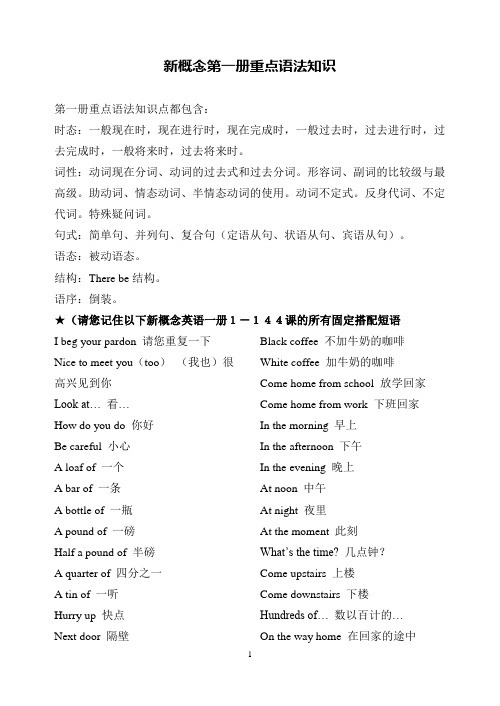
新概念第一册重点语法知识第一册重点语法知识点都包含:时态:一般现在时,现在进行时,现在完成时,一般过去时,过去进行时,过去完成时,一般将来时,过去将来时。
词性:动词现在分词、动词的过去式和过去分词。
形容词、副词的比较级与最高级。
助动词、情态动词、半情态动词的使用。
动词不定式。
反身代词、不定代词。
特殊疑问词。
句式:简单句、并列句、复合句(定语从句、状语从句、宾语从句)。
语态:被动语态。
结构:There be结构。
语序:倒装。
★(请您记住以下新概念英语一册1-144课的所有固定搭配短语I beg your pardon 请您重复一下Nice to meet you(too)(我也)很高兴见到你Look at… 看…How do you do 你好Be careful 小心A loaf of 一个A bar of 一条A bottle of 一瓶A pound of 一磅Half a pound of 半磅A quarter of 四分之一A tin of 一听Hurry up 快点Next door 隔壁Black coffee 不加牛奶的咖啡White coffee 加牛奶的咖啡Come home from school 放学回家Come home from work 下班回家In the morning 早上In the afternoon 下午In the evening 晚上At noon 中午At night 夜里At the moment 此刻What’s the time? 几点钟?Come upstairs 上楼Come downstairs 下楼Hundreds of… 数以百计的…On the way home 在回家的途中This morning 今天早晨This afternoon 今天下午This evening 今天晚上tonight 今天夜里Yesterday morning 昨天早晨Yesterday afternoon 昨天下午Yesterday evening 昨天晚上Last night 昨天夜里The day before yesterday in the morning 前天早晨The day before yesterday in the afternoon 前天下午The day before yesterday in the evening 前天晚上The night before last 前天夜间A low mark 分数很底A high mark 分数很高She said to herself 她心中暗想The way to… 到…的走法In fashion 流行的,时髦的I’m afraid… 我恐怕…I’m sure… 我确信,我肯定…A lot of 许多(用于肯定句)At all 丝毫、更本、一点也不Going on holiday 度假Have been to… 到过…All the time 一直,始终Have been to… 到过…Drive into… 撞倒…For sale 供出售、出售Have the last word 最后决定、最后才算The R.A.F. 英国皇家空军Return ticket 往返票Next door to… 与…相邻,在…隔壁In five hours’time 在五小时之后。
(完整版)新概念英语第一册所有语法点汇总)

新概念英语第一册所有语法点汇总Lesson 1 人称代词含有be动词的陈述句、否定句和一般疑问句Lesson 3 祈使句简单的倒装句Lesson 5 冠词Lesson 6 选择疑问句Lesson 7 特殊疑问句一般疑问句Lesson 9 How…?的一些社交上的用法形容词的意义与作用Lesson 11所有格形容词和所有格代词名词所有格Lesson 15 名词可数名词单数变复数的规则Lesson 16 名词复数-s或-es的发音规则Lesson 19 There be句型常见方位介词:in、on、over、under Lesson 21 动词的双宾语Lesson 23 定语Lesson 27 some, any一些Lesson 29 情态动词情态动词must的用法Lesson 31 时态:共十六种时态,时态是通过动词变化来实现的。
现在进行时Lesson 34 动词+ing的规则Lesson 35 短语动词Lesson 37 be going to句型宾语补足语Lesson 39 祈使句do的用法Lesson 40 词组:动词+介词Lesson 43 情态动词can的用法Lesson 47 一般现在时Lesson 48 序数词Lesson 49 动词加s(es) 规则动词不定式some、any用法Lesson 51 What…(be,look…) like? 频率副词Lesson 57 一般现在时与现在进行时Lesson 59 have/has的用法Lesson 61 主语+系动词+表语Lesson 63 each和every的区别Lesson 64 禁令Don’t and Mustn’tLesson 65 日期的表达反身代词Lesson 67 一般过去时动词的过去式变化否定疑问句Lesson 69 用介词at,on和in的时间短语Lesson 74 副词的用法副词的构成Lesson 75 宾语从句Lesson 79 Must与NeedLesson 83 现在完成时Lesson 85 现在完成时的特殊结构Lesson 89 for与sinceLesson 91 一般将来时Lesson 95 had better和mustLesson 99 宾语从句Lesson 100 直接引语和间接引语Lesson 101 反意疑问句Lesson 103 too与enough的用法Lesson 105 动词不定式Lesson 107 形容词的比较级和最高级Lesson 111 形容词的平级比较级Lesson 113 so与neither引导的简短回答Lesson 116 不定代词Lesson 117 过去进行时概念和结构Lesson 119 过去完成时Lesson 121 定语从句Lesson 123 感叹句Lesson 125 must, have to和needn’tLesson 127 表示猜测和推断的情态助动词must和can’tLesson 131 情态助动词may表示可能性Lesson 133 需改变时态的间接陈述句Lesson 135 Let的用法Lesson 137 条件从句Lesson 141 被动语态新概念英语第一册语法点归纳大纲新概念英语第一册语法点归纳新概念一共144课,其中单课为课文,双课为语法和练习。
新概念英语第一册语法知识点修订版

新概念英语第一册语法知识点Company number:【WTUT-WT88Y-W8BBGB-BWYTT-19998】★含有be动词的句子He is a teacher.The girl is very beautiful.Tim and Jack are students.★变疑问句将be动词移到句首Is he a teacherIs the girl very beautifulAre Tim and Jack students★变否定句在be动词后面加notHe is not a teacher.The girl is not very beautiful.Tim and Jack are not students.★肯定回答及否定回答Yes, he is. No, he is not.Yes, she is. No, she is not.Yes, they are. No, they are not.★含有一般动词的句子★第三人称单数及单数名词He likes books.She likes him.The dog likes bones.★变疑问句在句首加does, 动词变为原型Does he like booksDoes she like himDoes the dog like bones★变否定句在主语及动词之间加doesn’t, 动词变为原型He doesn’t like books.She doesn’t like him.The dog doesn’t like bones.★肯定回答及否定回答:Yes, he does. No, he doesn’t.Yes, she does. No, she doesn’tYes, it does. No, it doesn’t.注意:第三人称单数形式一般在动词后面加S。
★其他人称及复数名词I want to have a bath.We have some meat.The students like smart teachers.★变疑问句在句首加doDo you want to have a bathDo we have any meatDo the students like smart teachers★变否定句在主语和动词之间加don’t.You don’t want to have a bath.We don’t have any meat.The students don’t like smart teachers.★肯定回答及否定回答Yes, I do. No, I don’t.Yes, we do. No, we don’tYes, they do. No, they don’t.构成:主语+be动词+动词的现在分词+其它成分We are having lunch.He is reading a book.The dog is running after a cat.The boys are swimming across the river.★变疑问句将be动词移到句首Are we having lunchIs he reading a bookIs the dog running after a catAre the boys swimming across the river★变否定句在be动词后面加notWe are not having lunch.He is not reading a book.The dog is not running after a cat.The boys are swimming across the river.★特殊疑问句:what, which, how, where, who, etc.疑问词+be动词+主语+现在分词What are you doingWhat is she doingWhat is the dog doing没有进行时的动词(必背)表示状态、思想、感情、感觉的动词不能表示正在进行的动作1. 表示感觉、感官的词see, hear, like, love, want2. have, has作为动词”拥有”的含义时,没有进行时yesterday, last night, the day before yesterday, three days ago.含有be动词的句子,将动词变为过去式,am / is的变为was,are的变为wereI was at the butcher’s.You were a student a year ago.The teacher was very beautiful ten years ago.★变疑问句将be动词移动到句首Were you at the butcher’sWere you a student a year agoWas the teacher very beautiful ten years ago★变否定句在be动词后面加notI was not at the butcher’s.You were not a student a year ago.The teacher was not very beautiful ten years ago.★肯定回答否定回答Yes, I was. No, I was not.Yes, you were. No, you were not.Yes, he/she was. No, he/she was not.★特殊疑问句:What did you do不含有be动词的句子,将动词变为过去式,动词过去式构成见附录I finished my homework yesterday.The boy went to a restaurant.The Sawyers lived at King Streeta year ago.King Streeta year ago.★变疑问句在句首加did,动词变为原型Did you finish your homework yesterdayDid the boy go to a restaurantDid the Sawyers live at King Streeta year agoKing Streeta year ago★变否定句在主语和动词之间加did not,动词变为原型I did not finish my homework yesterday.The boy did not go to a restaurant.The Sawyers did not live at King Streeta year ago.King Streeta year ago.★肯定回答及否定回答Yes, I did. No, I didn’t.Yes, he did. No, he didn’t.Yes, they did. No, they did not.have/has+过去分词用法:1)表示过去发生且和现在有某种联系的动作,常和just, usually, already,since等时间副词连用I have just had lunch. (饱了,不用再吃了)He has had a cup of tea.(不渴了,不用再喝)They have already had their holiday. (不能再度假了)The boy has already read the book. (已经知道书的内容了,不用再看了)2)询问别人是否做过某事一般用现在完成时Have you finished your homeworkHave you been to BeijingHave he seen the film3)表示开始于过去并持续到现在的动作I have lived in Beijing for twenty years.I have worked for this school for 1 year.4)表示一种经历、经验:去过…地方,做过…事情,经历过…事情I have never had a bath.I have never seen a film.I have never been to cinema.I have ever been to Paris.Have been to表示去过,have gone to 表示去了I have been to London.(人已经回来)He has gone to London.(人还在那里)5)表示一种结果,一般不和时间副词联用I have lost my pen.I have hurt myself.He has become a teacher.She has broken my heart.句型变化:★变疑问句将助动词移到句首,变否定句在助动词后面加not.Have you lost your pen I have not lost my pen.★肯定回答及否定回答Yes, I have. No, I have not.★特殊疑问句:What have you doneWhat has he done一般过去时与现在完成时的区别:凡是有明确的表示过去的时间状语的句子为过去时注意:有些动词表示的动作有一个终点,不能再延续,因此不能和表示一段时间状语连用错:I’ve l eft Beijing for 3 days.对:I left Beijing 3 days ago. I have been away from being for 3 days.经常和tomorrow, next year, the day after tomorrow, the year after the next, in five hours’ time, etc. 表示将来的词联用结构:主语+助动词will+动词原形I will go to America tomorrow.The pilot will fly to Japan the month after the next.Jack will move into his new house tomorrow morning.★变疑问句将助动词移到句首Will you go to America tomorrowWill the pilot fly to Japan the month after the nextWill Jack move into his new house tomorrow morning★变否定句在助动词后面加notI will not go to America tomorrow.The pilot will not fly to Japan the month after the next.Jack will not move into his new house tomorrow morning★肯定回答及否定回答Yes, I will. No, I will not.Yes, he/she will. No, he/she will not.Yes, he will. No, he will not.★特殊疑问句:What will you do结构:had+过去分词After she had finished her homework, she went shopping.They had sold the car before I asked the price.The train had left before I arrived at the station.After/before引导的时间状语从句放在句首要在句子后面加逗号,如果放在主句后则不用。
新概念第一册重点语法知识

第一册重点语法知识点都包含:时态:一般现在时,现在进行时,现在完成时,一般过去时,过去进行时,过去完成时,一般将来时,过去将来时。
词性:动词现在分词、动词的过去式和过去分词。
形容词、副词的比较级与最高级。
助动词、情态动词、半情态动词的使用。
动词不定式。
反身代词、不定代词。
特殊疑问词。
句式:简单句、并列句、复合句(定语从句、状语从句、宾语从句)。
语态:被动语态。
结构:There be结构。
语序:倒装。
(请您记住以下新概念英语一册1-144课的所固定搭配短语)英文中文I beg your pardon 请您在重复(说)一遍Nice to meet you(too)(我也)很高兴见到你Look at… 看…How do you do 你好Be careful 小心A loaf of 一个A bar of 一条A bottle of 一瓶A pound of 一磅Half a pound of 半磅A quarter of 四分之一A tin of 一听Hurry up 快点Next door 隔壁Black coffee 不加牛奶的咖啡White coffee 加牛奶的咖啡Come home from school 放学回家Come home from work 下班回家In the morning 早上In the afternoon 下午In the evening 晚上At noon 中午At night 夜里At the moment 此刻What’s the time? 几点钟?Come upstairs 上楼Come downstairs 下楼Hundreds of… 数以百计的…On the way home 在回家的途中This morning 今天早晨This afternoon 今天下午This evening 今天晚上tonight 今天夜里Yesterday morning 昨天早晨Yesterday afternoon 昨天下午Yesterday evening 昨天晚上Last night 昨天夜里The day before yesterday in the morning 前天早晨The day before yesterday in the afternoon 前天下午The day before yesterday in the evening 前天晚上The night before last 前天夜间A low mark 分数很底A high mark 分数很高She said to herself 她心中暗想The way to… 到…的走法In fashion 流行的,时髦的I’m afraid… 我恐怕…I’m sure… 我确信,我肯定…A lot of 许多(用于肯定句)At all 丝毫、更本、一点也不Going on holiday 度假Have been to… 到过…All the time 一直,始终Have been to… 到过…Drive into… 撞倒…For sale 供出售、出售Have the last word 最后决定、最后才算The R.A.F. 英国皇家空军Return ticket 往返票Next door to… 与…相邻,在…隔壁In five hours’time 在五小时之后。
新概念第一册语法汇总

新概念第一册语法汇总新概念英语第一册是英语初学者的经典教材,其中包含了大量的语法知识。
以下是新概念第一册语法的汇总。
1.动词的时态和语态a.一般现在时:用于表示经常发生的动作或现实情况。
b.一般过去时:用于表示过去发生的动作或事件。
c.一般将来时:用于表示将来将要发生的动作或事件。
d.现在进行时:用于表示现在正在进行的动作。
e.过去进行时:用于表示过去一些时间正在进行的动作。
f.现在完成时:用于表示过去的动作对现在产生的影响。
g.过去完成时:用于表示过去一些时间前已经完成的动作。
h.一般条件句:用于表示条件和结果之间的关系。
i.被动语态:用于表示动作的接受者是动作的执行者。
2.名词a.可数名词和不可数名词:可数名词有单数和复数形式,不可数名词没有复数形式。
b.物主代词:用于表示所有关系。
c.不定代词:用于代替泛指的人或物。
3.介词a.用于表示时间、地点、原因等关系。
b. 常见的介词有in, on, at, by, with, for等。
4.形容词和副词a.用于修饰名词的词语。
b.形容词用于描述名词的性质或特征,副词用于描述动作的方式、程度等。
5.限定词a. 用于限定或修饰名词的词语,包括冠词(a, an, the)、指示代词(this, that, these, those)、数量词(some, any, many, much, a few, a little)、疑问代词(what, which, whose)等。
6.人称代词和物主代词a. 用于代替人或物的词语,包括主格代词(I, you, he, she, it, we, they)和宾格代词(me, you, him, her, it, us, them)。
7.情态动词a. 用于表示说话人的意愿、能力、推测等情态的动词,包括can, could, may, might, must, shall, should, will, would等。
8.疑问句和否定句a.用于表示疑问或否定的句子的结构和用法。
新概念第一册语法知识点汇总(完美版)
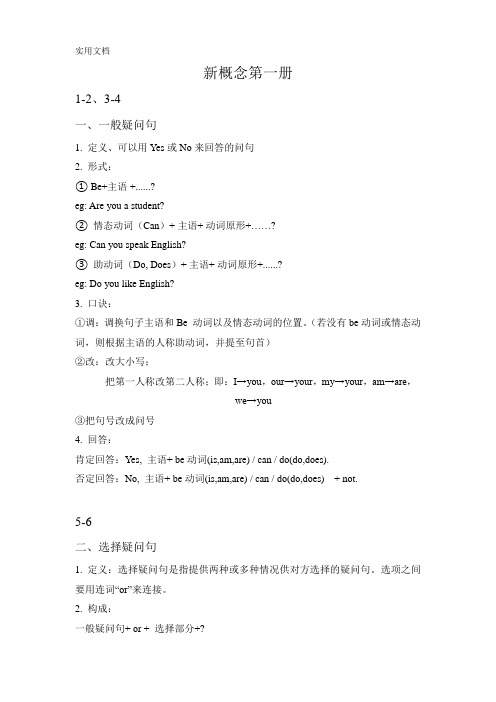
新概念第一册1-2、3-4一、一般疑问句1. 定义、可以用Yes或No来回答的问句2. 形式:① Be+主语 +......?eg: Are you a student?②情态动词(Can)+ 主语+ 动词原形+……?eg: Can you speak English?③助动词(Do, Does)+ 主语+ 动词原形+......?eg: Do you like English?3. 口诀:①调:调换句子主语和Be 动词以及情态动词的位置。
(若没有be动词或情态动词,则根据主语的人称助动词,并提至句首)②改:改大小写;把第一人称改第二人称;即:I→you,our→your,my→your,am→are,we→you③把句号改成问号4. 回答:肯定回答:Yes, 主语+ be动词(is,am,are) / can / do(do,does).否定回答:No, 主语+ be动词(is,am,are) / can / do(do,does) + not.5-6二、选择疑问句1. 定义:选择疑问句是指提供两种或多种情况供对方选择的疑问句。
选项之间要用连词“or”来连接。
2. 构成:一般疑问句+ or + 选择部分+?例:Are you a doctor or a teacher? 你是一个医生还是教师?Does he like this or that? 他喜欢这个还是喜欢那个?Is that coffee yours or hers? 这咖啡是你的还是她的?注:有时候选择部分会用“or not”来表示例:Are you ready or not (ready) ? 你准备好没有?Do you like the film or not? 你喜不喜欢这部电影?7-8、11-12、13-14三、特殊疑问句1. 含义:以特殊疑问词开头的疑问句。
2. 构成:特殊疑问词+一般疑问句+?3. 特殊疑问词总结:(1) what 什么(职业,姓名等)what day 星期几What day is it today? 几天星期几?what size 多大尺码What size are your shoes? 你的鞋码多大?what time 什么时间What time is it now? 现在几点了?what colour 什么颜色What color is your schoolbag? 你的书包是什么颜色?(2) when 什么时候(就时间提问)When will you visit Beijing? 你什么时候去北京玩?(3) where 什么地方(就地点提问)Where is your hometown? 你的家乡在哪?(4) who 谁(问人的身份,姓名等)Who is the girl in red dress? 穿着红裙子的女生是谁?(5) whose 谁的(whose + n.)Whose book is this?这是谁的书?(6) which 哪一个;哪些Which one is your sister ? 哪一个是你姐姐?(7) why 为什么(就原因提问,常用because回答)Why did you break the window?你为什么要打破窗户?(8) how 怎么样How do you go to school? 你怎么去学校?how many多少(提问可数名词数量)How many books do you have ?你有几本书?how much 多少(提问不可数名词数量)How much water is there in the glass?玻璃杯里有多少水?how much 多少钱(提问价格)How much is the ruler? 这把尺子多少钱?how old 几岁(提问年龄)How old are you? 你多少岁了?how long 多长(提问长度)How long is this ruler? 这把尺子有多长?多长时间(时间持续多久)How long do you go to school? 你去学校要多长时间?how often 多久一次(提问频率既单位时间发生多少次)how soon (还要多久时间才能开始或结束)How soon will he come back? 他多久才能回来?how heavy(提问有多重)How heavy is the luggage?这个行李箱有多重?9-10四、祈使句1. 定义:用于表达命令、请求、劝告、警告等的句子叫做祈使句。
新概念英语第一册语法知识点
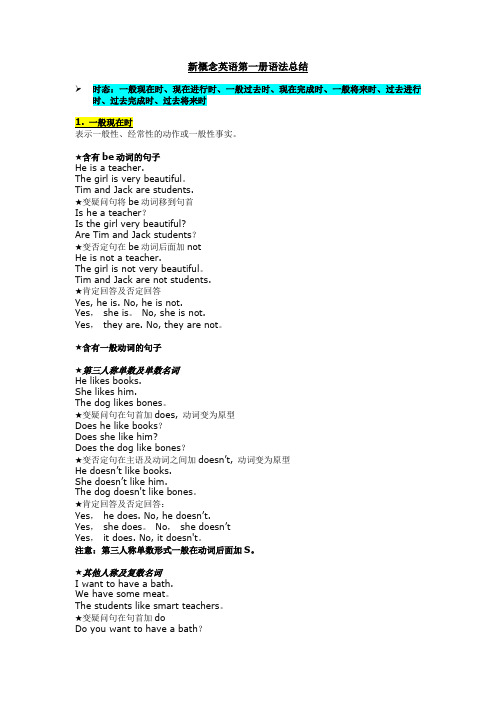
新概念英语第一册语法总结➢时态:一般现在时、现在进行时、一般过去时、现在完成时、一般将来时、过去进行时、过去完成时、过去将来时★含有be动词的句子He is a teacher.The girl is very beautiful。
Tim and Jack are students.★变疑问句将be动词移到句首Is he a teacher?Is the girl very beautiful?Are Tim and Jack students?★变否定句在be动词后面加notHe is not a teacher.The girl is not very beautiful。
Tim and Jack are not students.★肯定回答及否定回答Yes, he is. No, he is not.Yes,she is。
No, she is not.Yes,they are. No, they are not。
★含有一般动词的句子★第三人称单数及单数名词He likes books.She likes him.The dog likes bones。
★变疑问句在句首加does, 动词变为原型Does he like books?Does she like him?Does the dog like bones?★变否定句在主语及动词之间加doesn’t, 动词变为原型He doesn’t like books.She doesn’t like him.The dog doesn't like bones。
★肯定回答及否定回答:Yes,he does. No, he doesn’t.Yes,she does。
No,she doesn’tYes,it does. No, it doesn't。
注意:第三人称单数形式一般在动词后面加S。
★其他人称及复数名词I want to have a bath.We have some meat。
新概念一册语法知识大全
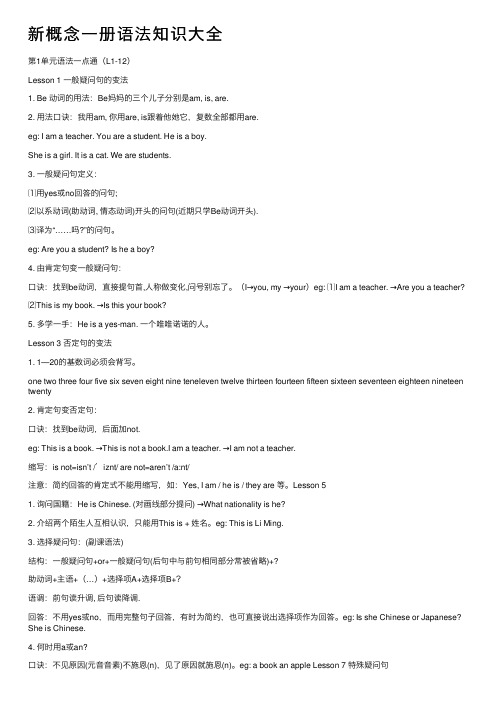
新概念⼀册语法知识⼤全第1单元语法⼀点通(L1-12)Lesson 1 ⼀般疑问句的变法1. Be 动词的⽤法:Be妈妈的三个⼉⼦分别是am, is, are.2. ⽤法⼝诀:我⽤am, 你⽤are, is跟着他她它,复数全部都⽤are.eg: I am a teacher. You are a student. He is a boy.She is a girl. It is a cat. We are students.3. ⼀般疑问句定义:⑴⽤yes或no回答的问句;⑵以系动词(助动词, 情态动词)开头的问句(近期只学Be动词开头).⑶译为“……吗?”的问句。
eg: Are you a student? Is he a boy?4. 由肯定句变⼀般疑问句:⼝诀:找到be动词,直接提句⾸,⼈称做变化,问号别忘了。
(I→you, my →your)eg: ⑴I am a teacher. →Are you a teacher?⑵This is my book. →Is this your book?5. 多学⼀⼿:He is a yes-man. ⼀个唯唯诺诺的⼈。
Lesson 3 否定句的变法1. 1—20的基数词必须会背写。
one two three four five six seven eight nine teneleven twelve thirteen fourteen fifteen sixteen seventeen eighteen nineteen twenty2. 肯定句变否定句:⼝诀:找到be动词,后⾯加not.eg: This is a book. →This is not a book.I am a teacher. →I am not a teacher.缩写:is not=isn’t /'iznt/ are not=aren’t /a:nt/注意:简约回答的肯定式不能⽤缩写,如:Yes, I am / he is / they are 等。
新概念英语第一册全部语法
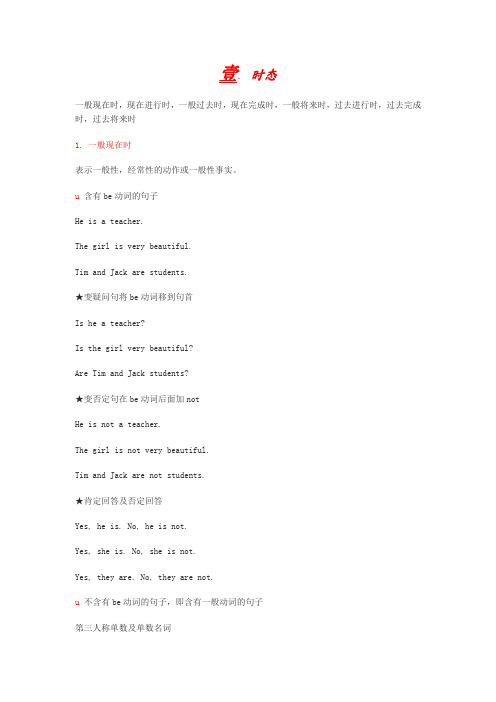
壹.时态一般现在时,现在进行时,一般过去时,现在完成时,一般将来时,过去进行时,过去完成时,过去将来时1. 一般现在时表示一般性,经常性的动作或一般性事实。
u含有be动词的句子He is a teacher.The girl is very beautiful.Tim and Jack are students.★变疑问句将be动词移到句首Is he a teacher?Is the girl very beautiful?Are Tim and Jack students?★变否定句在be动词后面加notHe is not a teacher.The girl is not very beautiful.Tim and Jack are not students.★肯定回答及否定回答Yes, he is. No, he is not.Yes, she is. No, she is not.Yes, they are. No, they are not.u不含有be动词的句子,即含有一般动词的句子第三人称单数及单数名词He likes books.She likes him.The dog likes bones.★变疑问句在句首加does, 动词变为原型Does he like books?Does she like him?Does the dog like bones?★变否定句在主语及动词之间加doesn’t, 动词变为原型He doesn’t like books.She doesn’t like him.The dog doesn’t like bones.★肯定回答及否定回答:Yes, he does. No, he doesn’t.Yes, she does. No, she doesn’tYes, it does. No, it doesn’t.注意:第三人称单数形式一般在动词后面加S,不要和名词复数混淆,变否定句或疑问句时名词复数没有任何变化。
新概念第一册语法知识点汇总(完美版)

新概念第一册1-2、3-4一、一般疑问句1. 定义、可以用Yes或No来回答的问句2. 形式:① Be+主语 +......?eg: Are you a student?②情态动词(Can)+ 主语+ 动词原形+……?eg: Can you speak English?③助动词(Do, Does)+ 主语+ 动词原形+......?eg: Do you like English?3. 口诀:①调:调换句子主语和Be 动词以及情态动词的位置。
(若没有be动词或情态动词,则根据主语的人称助动词,并提至句首)②改:改大小写;把第一人称改第二人称;即:I→you,our→your,my→your,am→are,we→you③把句号改成问号4. 回答:肯定回答:Yes, 主语+ be动词(is,am,are) / can / do(do,does).否定回答:No, 主语+ be动词(is,am,are) / can / do(do,does) + not.5-6二、选择疑问句1. 定义:选择疑问句是指提供两种或多种情况供对方选择的疑问句。
选项之间要用连词“or”来连接。
2. 构成:一般疑问句+ or + 选择部分+?例:Are you a doctor or a teacher? 你是一个医生还是教师?Does he like this or that? 他喜欢这个还是喜欢那个?Is that coffee yours or hers? 这咖啡是你的还是她的?注:有时候选择部分会用“or not”来表示例:Are you ready or not (ready) ? 你准备好没有?Do you like the film or not? 你喜不喜欢这部电影?7-8、11-12、13-14三、特殊疑问句1. 含义:以特殊疑问词开头的疑问句。
2. 构成:特殊疑问词+一般疑问句+?3. 特殊疑问词总结:(1) what 什么(职业,姓名等)what day 星期几What day is it today? 几天星期几?what size 多大尺码What size are your shoes? 你的鞋码多大?what time 什么时间What time is it now? 现在几点了?what colour 什么颜色What color is your schoolbag? 你的书包是什么颜色?(2) when 什么时候(就时间提问)When will you visit Beijing? 你什么时候去北京玩?(3) where 什么地方(就地点提问)Where is your hometown? 你的家乡在哪?(4) who 谁(问人的身份,姓名等)Who is the girl in red dress? 穿着红裙子的女生是谁?(5) whose 谁的(whose + n.)Whose book is this?这是谁的书?(6) which 哪一个;哪些Which one is your sister ? 哪一个是你姐姐?(7) why 为什么(就原因提问,常用because回答)Why did you break the window?你为什么要打破窗户?(8) how 怎么样How do you go to school? 你怎么去学校?how many多少(提问可数名词数量)How many books do you have ?你有几本书?how much 多少(提问不可数名词数量)How much water is there in the glass?玻璃杯里有多少水?how much 多少钱(提问价格)How much is the ruler? 这把尺子多少钱?how old 几岁(提问年龄)How old are you? 你多少岁了?how long 多长(提问长度)How long is this ruler? 这把尺子有多长?多长时间(时间持续多久)How long do you go to school? 你去学校要多长时间?how often 多久一次(提问频率既单位时间发生多少次)how soon (还要多久时间才能开始或结束)How soon will he come back? 他多久才能回来?how heavy(提问有多重)How heavy is the luggage?这个行李箱有多重?9-10四、祈使句1. 定义:用于表达命令、请求、劝告、警告等的句子叫做祈使句。
- 1、下载文档前请自行甄别文档内容的完整性,平台不提供额外的编辑、内容补充、找答案等附加服务。
- 2、"仅部分预览"的文档,不可在线预览部分如存在完整性等问题,可反馈申请退款(可完整预览的文档不适用该条件!)。
- 3、如文档侵犯您的权益,请联系客服反馈,我们会尽快为您处理(人工客服工作时间:9:00-18:30)。
新概念一主要语法知识点(一)时态主要涉及的时态有:一般现在时,现在进行时,一般过去时,现在完成时,一般将来时,过去进行时,过去完成时,过去将来时1. 一般现在时表示一般性,经常性的动作或一般性事实。
•含有be动词的句子例:He is a teacher.The girl is very beautiful.Tim and Jack are students.★变疑问句将be动词移到句首·例:Is he a teacher?Is the girl very beautiful?Are Tim and Jack students?★变否定句在be动词后面加not例:He is not a teacher.The girl is not very beautiful.Tim and Jack are not students.★肯定回答及否定回答例:Yes, he is. No, he is not.Yes, she is. No, she is not.Yes, they are. No, they are not.•不含有动词的句子,即含有一般动词的句子第三人称单数及单数名词例:He likes books.She likes him.The dog likes bones.★变疑问句在句首加does,动词变为原型例:Does he like books?Does she like him?Does the dog like bones?★变否定句在主语及动词之间加doesn’t, 动词变为原型例:He doesn’t like books.She doesn’t like him.The dog doesn’t like bones.★肯定回答及否定回答:例:Yes, he does. No, he doesn’t.Yes, she does. No, she doesn’tYes, it does. No, it doesn’t.注意:第三人称单数形式一般在动词后面加S,不要和名词复数混淆,变否定句或疑问句时名词复数没有任何变化。
其他人称及复数名词例:I want to have a bath.We have some meat.The students like smart teachers.★变疑问句在句首加do例:Do you want to have a bath?Do we have any meat?Do the students like smart teachers?★变否定句在主语和动词之间加don’t.例:You do n’t want to have a bath.We don’t have any meat.The students don’t like smart teachers.★肯定回答及否定回答例:Yes, I do. No, I don’t.Yes, we do. No, we don’tYes, they do. No, they don’t.2. 现在进行时表示现在正在进行的动作。
构成:主语+be动词+动词的现在分词+其它成分例:We are having lunch.He is reading a book.The dog is running after a cat.The boys are swimming across the river.★变疑问句将be动词移到句首例:Are we having lunch?Is he reading a book?Is the dog running after a cat?Are the boys swimming across the river?★变否定句在be动词后面加not例:We are not having lunch.He is not reading a book.The dog is not running after a cat.The boys are swimming across the river.★特殊疑问句:what,which, how, where, who, etc.疑问词+动词+主语+现在分词例:What are you doing?What is she doing?What is the dog doing?注:(必背!!)没有进行时的动词:表示状态,思想,感情和感觉的动词不能表示正在进行的动作①表示感觉,感官的词see, hear, like, love, want,② have, has当”拥有”讲时没有进行时3. 一般过去时表示过去发生的动作或事件,常和表示过去的时间状语连用,如yesterday, last night, the day before yesterday, 3 days ago,•含有be动词的句子,将动词变为过去式,am, is的过去式为was,are的过去式为were例:I was at the butcher’s.You were a student a year ago.The teacher was very beautiful ten yearsago.★变疑问句将be动词移动到句首例:Were you at the butcher’s?Were you a student a year ago?Was the teacher very beautiful ten yearsago?★变否定句在be动词后面加not例:I was not at the butcher’s.You were not a student a year ago.The teacher was not very beautiful tenyears ago.★肯定回答否定回答例:Yes, I was. No, I was not.Yes, you were. No, you were not.Yes, he/she was. No, he/she was not.★特殊疑问句:例:What did you do?•不含有be动词的句子,将动词变为过去式例:I finished my homework yesterday.The boy went to a restaurant.The Sawyers lived at King Street a year ago.★变疑问句在句首加did,动词变为原型例:Did you finish your homework yesterday?Did the boy go to a restaurant?Did the Sawyers live at King Street a year ago?★变否定句在主语和动词之间加didnot例:I did not finish my homework yesterday.The boy did not go to a restaurant.The Sawyers did not live at King Street a yearago.★肯定回答及否定回答例:Yes, I did. No, I didn’t.Yes, he did. No, he didn’t.Yes, they did. No, they did not.4. 现在完成时构成:主语+助动词have, has+过去分词用法:1)表示过去发生的和现在有某种联系的动作,常和just, usually, already, since等时间副词连用例:I have just had lunch. (饱了,不用再吃了)He has had a cup of tea.(不渴了,不用再喝)They have already had their holiday. (不能再度假了)The boy has already read the book. (已经知道书的内容了,不用再看了)2)询问别人是否做过某事一般用现在完成时:例:Have you finished your homework?Have you been to Beijing?Have he seen the film?3)表示开始于过去并持续到现在的动作例:I have lived in Beijing for twenty years.I have worked for this school for 1 year.4)表示一种经历,经验:去过…地方,做过…事情,经历过…事情例:I have never had a bath.I have never seen a film.I have never been to cinema.I have ever been to Paris.注意:Have been to表示去过,have gone to 表示去了试比较:I have been to London.(人已经回来)He has gone to London.(人还在那里)5)表示一种结果,一般不和时间副词联用例:I have lost my pen.I have hurt myself.He has become a teacher.She has broken my heart.★变疑问句将助动词移到句首,例:Have you lost your pen?★变否定句在助动词后面加not.例: I have notlost my pen.★肯定回答及否定回答例:Yes, I have. No, I have not.★特殊疑问句:例:What have you done?What has he done?注意:一般过去时与现在完成时的区别:凡是有明确的表示过去的时间状语的句子为过去时注意:有些动词表示的动作有一个终点,不能再延续,因此不能和表示一段时间状语连用错:I’ve left Beijing for 3 days.对:I left Beijing 3 days ago. Ihave been away from being for 3 days.5. 一般将来时表示将来将要发生的动作,经常和tomorrow, next year, the dayafter tomorrow, the year after the next, in five hours’time, etc. 表示将来的词联用结构:主语+助动词will+动词原形例:I will go to America tomorrow.The pilot will fly to Japan the monthafter the next.Jack will move into his new house tomorrowmorning.★变疑问句将助动词移到句首例:Will you go to America tomorrow?Will the pilot fly to Japan the month afterthe next?Will Jack move into his new house tomorrowmorning?★变否定句在助动词后面加not例:I will not go to America tomorrow.The pilot will not fly to Japan the monthafter the next.Jack will not move into his new housetomorrow morning★肯定回答及否定回答例:Yes, I will. No, I will not.Yes, he/she will. No, he/she will not.Yes, he will. No, he will not.★特殊疑问句:例:What will you do?6. 过去完成时:用法:在过去的时间里,两个动作中,发生在前的哪个动作要用过去完成时。
